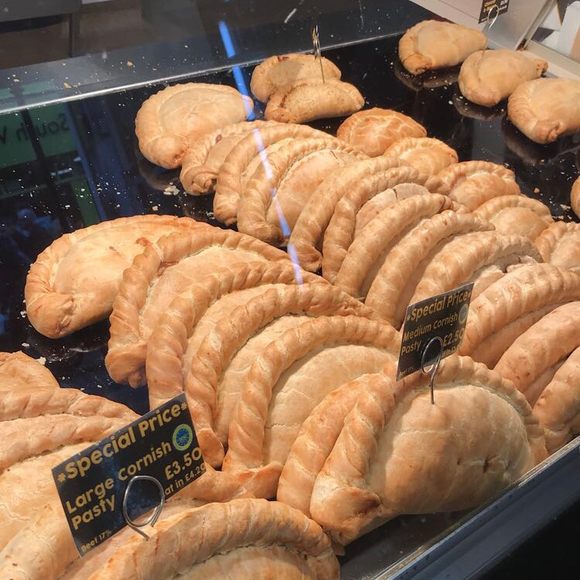Prepared Foods
Cornish Pasty
In the 19th century, tin miners ate these handheld pies and left their crusts to appease mischievous, mine-dwelling spirits.
The savory handheld pie known as the pasty appears in British documents dating back as early as the 14th century. But it was Cornish tin miners who popularized the portable meals in the 19th century. Since they worked at depths too great to return to the surface for breaks, they needed something that they could easily bring down to the mines with them. The pasties acted as both lunchbox and lunch. Thanks to their sealed pockets of beef, potato, onion, and swede (rutabaga), they kept warm for long stretches of time. Even their signature half-circle shapes were intended for maximum mobility, with their curved, crimped crust acting as a sort of handle.
There are several theories surrounding the pasty’s crimped crust. Some say it was not meant to be eaten (since the miners’ hands may have been contaminated with arsenic, a byproduct of processing tin), but others argue that the miners likely ate their pies in some kind of wrapping to avoid ingesting any toxins. Another possible use of the crust? An offering to “knockers,” mischievous, mine-dwelling spirits believed to cause trouble if they weren’t appeased with treats.
Now a staple Cornish food, the pasty is served everywhere from weddings to rugby matches to school cafeterias. It’s even traveled to the United States, where Cornish immigrants brought their handy lunches to Michigan’s Upper Peninsula, another region with a long history of mining.
Where to Try It
-
This place is easy to find and they have several outposts around Cornwall. The prices are between £1.50 and £3.50, depending on the pasty sizes. They have the traditional pasties or many other modern options such as vegetarian, gluten free, etc.
-
Red Rooster Cafe Website
158 High St, Mineral Point, Wisconsin, 53565, United StatesMineral Point, where the Red Rooster is located, was famous for its lead mining industry in the nineteenth century. The miners frequently ate pasties in the mines, and so they're relatively common in Southern Wisconsin.
Written By
t tamsuleimanSources
- www.cornishpastyassociation.co.uk/about-the-pasty/history/
- www.history.com/news/miners-delight-the-history-of-the-cornish-pasty
- www.historic-uk.com/CultureUK/The-Cornish-Pasty/
- www.cornwalls.co.uk/photos/arsenic-labyrinth-botallack-mine.htm
- books.google.com/books?id=0hvx6Ga1F8AC&pg=PA144&dq=knockers+cornish+pasty&hl=en&sa=X&ved=0ahUKEwihgpf5_8rfAhWHTt8KHWWYAmIQ6AEIKDAA#v=onepage&q=knockers%20cornish%20pasty&f=false
- books.google.com/books?id=rkG8f2lyeUMC&pg=PA238&dq=knockers+cornish+pasty&hl=en&sa=X&ved=0ahUKEwihgpf5_8rfAhWHTt8KHWWYAmIQ6AEILTAB#v=onepage&q=knockers%20cornish%20pasty&f=false
- books.google.com/books?id=RL6LAwAAQBAJ&pg=PA604&dq=oxford+english+dictionary+pasty&hl=en&sa=X&ved=0ahUKEwicuPSYg8vfAhWHr1kKHSLtAnYQ6AEILDAB#v=onepage&q=oxford%20english%20dictionary%20pasty&f=false










